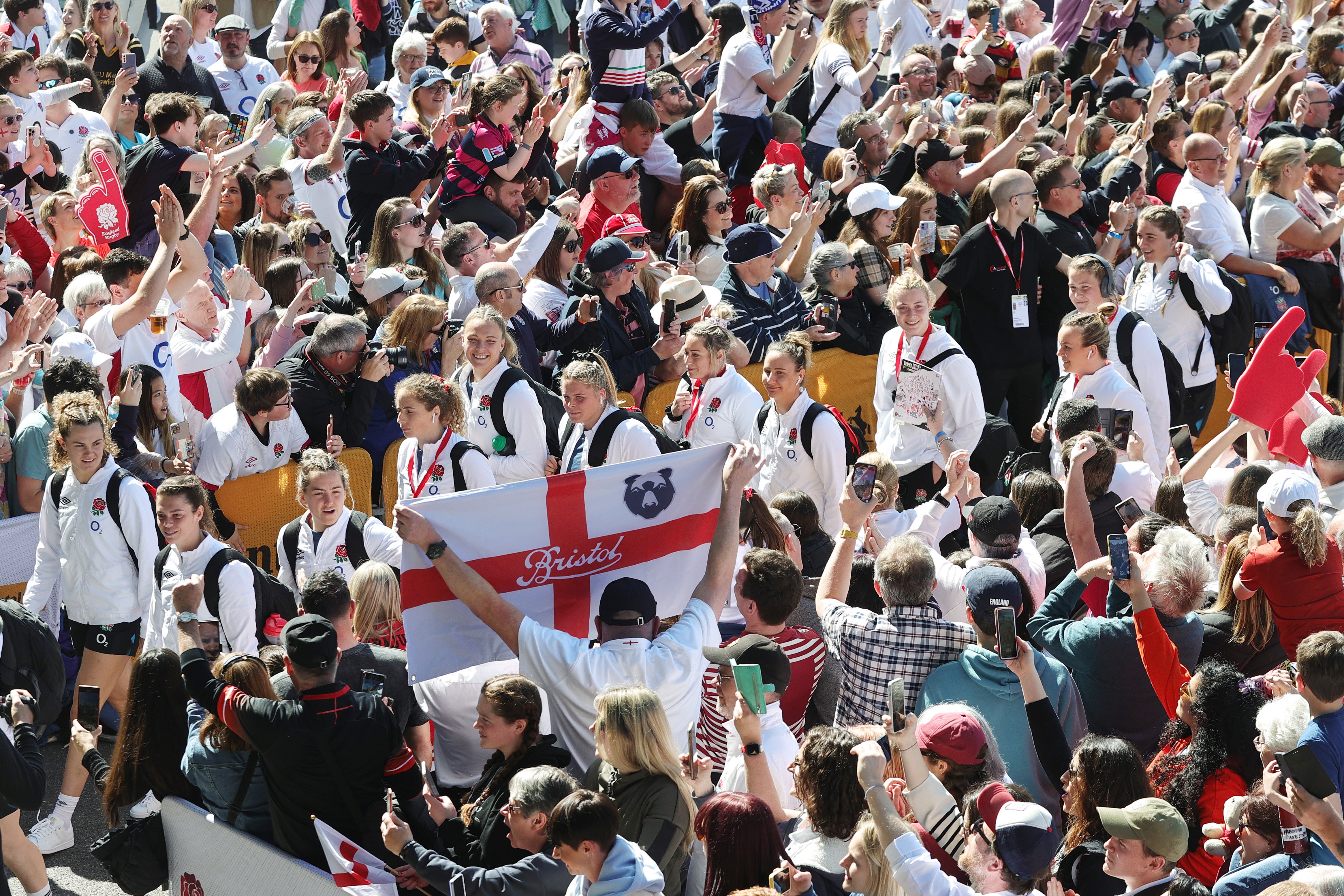
The great and the good of women’s rugby disappeared into the Twickenham evening, faces warmed by the spring sunshine, hearts warmed by the occasion. It had been a day where everything and everyone came together for a long-awaited afternoon that brought a real festival feel, with close to 60,000 people revelling in a celebration of progress made.
From the first knockings until deep into Saturday night, the streets around Twickenham were alive. Families in matching shirts filed on to the morning rattlers, many granted a first opportunity to visit the home of English rugby. It meant a very different experience to a men’s Six Nations Saturday, imbued with a positive party spirit. Throughout an odd contest that saw long passages dominated by each side, the crowd remained engaged, roaring every positive English involvement, lifting the home side in the low moments and celebrating the first half highs wildly.
“I can’t put into words how good it was,” said England captain Marlie Packer afterwards. “The bus journey into Twickenham today was a pinch yourself moment. There were fans all along the streets and it was a very special occasion from start to finish.”
The question now is how England build from here to ensure there are many more days like this. The Rugby Football Union’s ambition to fill Twickenham for the final of the 2025 World Cup now seems almost a certainty, with ticket sales for this encounter significantly higher than initial internal projections. Saturday’s contest made clear that the Red Roses will soon be capable of consistently holding their fixtures at the home of English rugby. The RFU’s investment in the sport is paying dividends.
But managing the next couple of years might be trickier than first appears. After such a positive experience, a swift return will feel natural, though there will be caution not to chase too much, too soon. Twickenham can feel a mightily empty place when less than half full, but there are few stadia with suitable capacity to enable Red Roses audiences to boom as they should without consistent visits to south-west London.

Visits to football grounds have been mooted by some, but could prove logistically and financially difficult. As interest grows, basic economics suggests that ticket prices will, too, but care must also be taken not to price out a younger and more diverse audience that is a great strength of the women’s game.
Next year’s Six Nations will bring home fixtures against Wales and Ireland. Both will lack the promise of genuine contest that the grand slam decider had, though that is yet to prove a major inhibiting factor on crowd size. Grounds near the River Severn are logically favoured against Wales and Ashton Gate, with a capacity of 27,000, would be a sensible place to take that fixture if not deemed quite ready for a Twickenham return. Selling out the Bristol venue would be an achievable next step and allow the Red Roses to maintain their close connection with their fanbase across the country.
“I think one thing we are really trying to work on as a team is making our own brand and making something that actually is viable,” wing Abby Dow explained. “At the end of the day, professional rugby is about the financial situation as well. Yes, we can get 58,000 people coming down to Twickenham, but that’s for Le Crunch. What we need to be able to do is get that consistently for every single Six Nations game.
“When we can get that, that’s when we can actually bring it to Twickenham. But what we are doing now by going across the country is inspiring people throughout the country which is something we don’t quite get to see as much with the men’s team. We are more than happy to keep doing that.”
The international schedule for the rest of the year is not yet confirmed, with a possibility of England holding some warm-up fixtures before they head to the inaugural WXV in the autumn. Information about World Rugby’s new competition, which will be held during the men’s Rugby World Cup, has been slow to emerge, though official news is expected in the coming days that New Zealand will host the top tier. South Africa and Dubai are thought to be contenders to hold the second and third-tier events respectively.
England are expected to have hosting rights for the top tier of WXV next year, when the competition will have clearer air in which to breathe. A Black Ferns visit to Twickenham as part of the tournament would surely appeal - could the goal of selling out perhaps yet be achieved before the World Cup?
“I believe we can do it and I believe we can do it before 2025 for the World Cup final,” Packer stressed. “Look at today - we weren’t a curtain raiser; it was all about us. Everything is on the rise so more tickets will be sold and more stadiums will sell out.”







